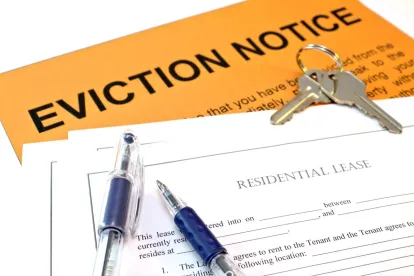Across the country, the federal government along with state and local governments and courts are taking measures to limit evictions and foreclosures. Financial institutions, servicers, and landlords facing anticipated defaults across their portfolios should stay abreast of the limitations in order to avoid heightened risks. Tenants and mortgagors likewise have contractual obligations at stake and need to understand options for recourse.
Key considerations for these ON PAUSE issues are:
-
Once well-established procedures for addressing real estate-related defaults are now in flux.
-
On the residential side, a 60-day federally-imposed moratorium on evictions and foreclosures is now in place for FHA, Fannie, and Freddie single-family loans. Mortgage assistance and relief directives are also in place.
-
Few states are moving at the statewide level with more activity being seen on the city and county level.
-
Limitations are not confined to residential properties, and restrictions on remedies and default procedures have also been imposed for commercial properties.
-
Limitations are also not uniform in duration, and extensions of 30 or 60 day moratoriums are possible.
-
-
There is no suggestion that the directives seek to curb contractual payment obligations or default remedies that accrue after the moratoriums end, but relief programs may prescribe new rules.
-
Real estate relationships are generally geared toward the long-term. For property owners, tenants, landlords, and lenders, communication is essential for confining the temporary impact and preventing long-term, irreversible consequences. Understanding options for a deferment, forbearance, increased credit facility, or a line of credit are important considerations.
-
If your real estate interests span jurisdictions, compliance is a major concern, and aggressive measures carry higher risks, along with feasibility and reputational issues. A conservative approach to default remedies may help keep long-term relationships in place, avoid litigation, and prevent a contractual issue from devolving into a tort dispute.
-
Extensions and changes are likely, so compliance planning needs to anticipate regularly updating policies based on the duration of the limitations that impact your business.
Moratoriums - Federal Level
On March 18, 2020, the FHA announced a 60-day moratorium on foreclosure and evictions for single family homeowners with FHA-backed loans. The guidance applies to all FHA Title II Single Family forward and Home Equity Conversion Mortgage (reverse) mortgage programs. The decision is aimed at addressing the financial impact faced by homeowners, as well as recognition of the importance of the ability of families to stay in their homes to comply with containment measures.
This federal announcement probably has the largest single-stroke impact on the residential loan market, but many homeowners may be unaware of whether or not their loan is FHA-insured. Servicer communications need to be mindful of the potential knowledge gap. Even for non-FHA loans, risks are heightened based on a moving target of compliance with eviction and foreclosure rules varying at the state, city, and county levels.
Moratoriums - State and Local
Inconsistency is an issue as few states are moving at the statewide level. More activity is being seen on the city and county level, both by municipal governments and local courts. In California, the governor issued an executive order on March 16, 2020 aimed at curbing evictions and foreclosures. But the scope and impact of the order is really left up to local municipalities. Governments in major population centers such as Los Angeles and San Francisco have already enacted moratoriums on evictions resulting from COVID-19, and many more local governments across the state are in the process of doing the same.
This patchwork of moratoria is also emerging in other states, starting with those hardest hit by COVID-19. In New York, the governor issued an executive order on March 20, 2020 prohibiting “enforcement of either an eviction of any tenant residential or commercial, or a foreclosure of any residential or commercial property for a period of ninety days.” In Washington, the governor issued an executive order on March 18, 2020, pausing residential evictions for a period of 30 days. However, other municipalities in the state have imposed greater restrictions. For example, the Seattle Mayor issued an emergency order on March 16, 2020 imposing a moratorium on residential evictions for 60 days.
Similarly, court closures across jurisdictions present feasibility issues for foreclosure and eviction proceedings, with an inevitable backlog of proceedings to be addressed down the road. Many courts, state and federal, have emergency orders in place aimed at suspension of non-essential proceedings. There orders themselves vary, and there’s debate over how evictions and foreclosures are impacted.
For example, in Fulton County, which encompasses a large portion of the Atlanta Metro, the Magistrate Court and Fulton County Marshal announced on March 20, 2020 coordinated efforts to ensure that all evictions are suspended for the duration of the limited Judicial Emergency, declared by the Georgia Supreme Court (currently, through April 14, 2020). The announcement came after formal suspension by the Chief Magistrate of eviction hearings. But such measures are not consistent across the 159 counties in Georgia.
In contrast, in South Carolina, on March 18, 2020, the Chief Justice of the state’s Supreme Court issued an order “to address statewide evictions and foreclosures” based on the concern that “increased housing insecurity and homelessness will worsen the threat posed by the illness.” Under the order, then-pending evictions are to be rescheduled for a date of May 1, 2020 or later, and an indefinite moratorium is placed on future eviction-related proceedings and foreclosure hearings and sales.
These directives involve the intersection of law, politics, health, and safety and are highly emotional. The resulting uncertainty and risk warrants caution in practice, necessitates communication with parties whose interests may diverge, and, depending on the circumstances, is aided by consultation with counsel.
Protecting Relationships
Tenants, landlords, and lenders are aligned in seeking continuation of real estate relationships that tend to be geared toward the long-term. For leasing parties, the implications of suspension of performance obligations is often lease specific. Aside from payment issues, more complicated issues surround properties experiencing exposure or actual contamination, especially for multi-tenant properties or properties with common spaces. An agreed upon temporary rent deferral may be the right fit for addressing short-term payment issues and maintaining good tenant relationships. Many larger retailers have reportedly already made such requests, but the downstream impact is that doing so potentially implicates the landlord’s relationship with its lender. Tenants and landlords need to consider if rent payment issues violate lending covenants or require disclosure.
Lenders likewise are looking to keep their portfolios performing. From a practical standpoint, foreclosures and default remedies are not likely feasible in the coming months, either due to governmental limitations, court closures and backlogs, or reputational risks. Payment deferments are likely the most common sense tool for loans without a default history and facing temporary cash flow issues. The deferments may be interest only or principal and interest. Other alternatives may be for landlords to restructure rent obligations around interest obligations or take out additional financing to address temporary cash flows.
The moratorium actions discussed above include calls to financial institutions to make available loan assistance options. For homeowners, Fannie Mae and Freddie Mac have directives in place to provide impacted homeowners with forbearance options that include waivers of penalties and late fees, suspending credit reporting for certain delinquencies, and offering loan modifications. Similar policies across the mortgage industry may follow. California’s executive order, discussed above, contains provisions directing engagement with financial institutions to “identify tools to be used to afford Californians relief from the threat of residential foreclosure and displacement” and requests that financial institutions voluntarily implement immediate moratoriums.
For small business, the SBA issued a March 10, 2020 notice “to remind” SBA lenders of “their unilateral authority to provide temporary relief in the form of deferred payments to existing borrowers under certain circumstances.” Small business borrowers with SBA loans may have options for seeking temporary deferments. For SBA and other commercial loans, doing so sooner rather than later may be the right move as lending protocols can pose limits for loans already in default for more than 60 days and deferments are often subject to review of current financials. To be viable, lenders and borrowers need to document the temporary nature of the cash flow issue and projected recovery.
While evictions are squarely targeted by interim moratorium measures, it is less clear whether the same level of restrictions will be imposed upon foreclosures. Even so, pressing forward with foreclosures in the current environment presents risks well beyond pure legal exposure. And whatever the case is now, quickly evolving events on the ground means servicers must stay nimble, and expect to enact significant changes to loss mitigation practices during this ON PAUSE period.
ON PAUSE, Thinking Ahead
Consider consulting counsel if your business would be aided by the following:
-
Assessing compliance for loan servicing in light of changing legal ramifications for default remedies.
-
Reviewing lease obligations to address “shelter in place” or other government order implications and potential force majeure issues.
-
Drafting a suspension agreement to address a short term rent deferral.
-
Reviewing loan documents for covenants and formulating lender disclosures.
-
Negotiating a forbearance agreement or loan modification with a mind toward understanding and documenting short term performance issues.
-
Pursuing expansion of credit arrangements to address cash flows.
-
Understanding potential related insurance coverage issues.




 />i
/>i

